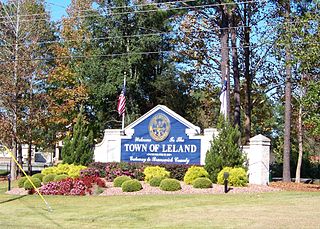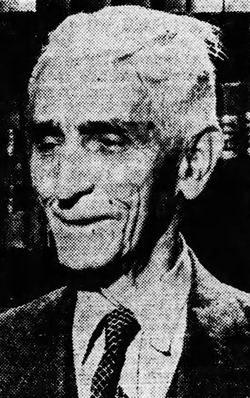
Haywood County is a county located in the U.S. state of North Carolina. As of the 2020 census, the population was 62,089. The county seat and its largest community is Waynesville.

Leland is the most populous town in Brunswick County, North Carolina, United States. The population was 23,504 at the 2020 census, up from 13,527 in 2010. As of 2020, it is considered to be one of the fastest growing towns in North Carolina. It is part of the Wilmington, NC Metropolitan Statistical Area. and the Cape Fear Council of Governments. The town of Leland is in the northeastern part of Brunswick County, with the town of Navassa to the north, Belville to east, and Boiling Spring Lakes to the south. It is part of the Town Creek township, and Cape Fear region of North Carolina, a short distance north of the South Carolina state line. Leland is located five miles (8.0 km) west of Wilmington, 71 miles (114 km) north of Myrtle Beach, 84 miles (135 km) southeast of Fayetteville, and 135 miles (217 km) southeast of Raleigh.

Clyde is a town in Haywood County, North Carolina, United States. The 2010 census recorded the population at 1,223 people. It is part of the Asheville Metropolitan Statistical Area.

Lake Junaluska is a census-designated place (CDP) in Haywood County, North Carolina, United States, and an artificial lake in the Blue Ridge Mountains. It is part of the Asheville Metropolitan Statistical Area.

Waynesville is the county seat of Haywood County, North Carolina, United States. It is the largest town in North Carolina west of Asheville. Waynesville is located about 30 miles (50 km) southwest of Asheville between the Great Smoky and Blue Ridge Mountains.

Joe Sam Queen is a North American Democratic Party politician and architect from North Carolina. He has served in both the North Carolina Senate and the North Carolina House of Representatives.

U.S. Route 276 is a United States highway that runs for 106.4 miles (171.2 km) from Mauldin, South Carolina to Cove Creek, North Carolina. It is known both as a busy urban highway in Greenville, South Carolina and a scenic back-road in Western North Carolina. Despite its numbering, it does not intersect its parent route U.S. Route 76.

Tuscola High School is a public senior high school located in Waynesville, North Carolina, United States, about 30 miles west-southwest of Asheville. Tuscola High School succeeded the original Waynesville Township High School during the 1966 consolidation that merged Fines Creek and Crabtree High Schools with Waynesville. The school was built in the Tuscola community of East Waynesville, near Lake Junaluska and was named after the community in which it was built. Tuscola is a Cherokee word that means "Digging in Many Places". The school's mascot is a Mountaineer and the school colors are black and gold.

Margaret Mary Carpenter was a Republican member of the North Carolina House of Representatives from the fifty-second district for one term (2001–2002). Carpenter, a resident of Waynesville, North Carolina, defeated Haywood County Commissioner and former Hazelwood Mayor, Mary Ann Enloe, by a narrow margin in 2000.

The Murphy Branch is a branch line operated by the Western North Carolina Railroad, later the Richmond and Danville, Southern Railway, the Norfolk Southern Railway (NS) and today the Blue Ridge Southern Railroad. The branch runs between Asheville, North Carolina in the east and Murphy in the west.
Robert Love was an American Revolutionary War soldier from Virginia and a political leader in North Carolina.

The Asheville metropolitan area is a metropolitan area centered on the principal city of Asheville, North Carolina. The U.S. Office of Management and Budget defines the Asheville, NC Metropolitan Statistical Area, a metropolitan statistical area used by the United States Census Bureau and other entities, as comprising the four counties of Buncombe, Haywood, Henderson, and Madison. The area's population was 424,858 according to the 2010 census, and 469,454 according to the 2020 census.
The Mountaineer is a newspaper based in Waynesville, North Carolina. The newspaper is owned by The Mountaineer Publishing Company.
Eaglenest Mountain is a mountain located 2 miles south of Maggie Valley, North Carolina in Haywood County. It is part of the Plott Balsams, a range of the Appalachian Mountains, and less than a mile south of North Eaglenest Mountain, a higher mountain which used to be called Mount Junaluska and is the highest mountain overlooking Lake Junaluska from the southwest. The closest town that is accessible by road is Hazelwood. Hazelwood was absorbed into the larger incorporated Town of Waynesville in 1995.
Folkmoot USA, The State International Festival of North Carolina, is an international folk festival held since 1984 in Waynesville, North Carolina and surrounding communities. During its history, the two-week event has featured around 8000 performers from approximately 200 countries. The Folkmoot USA non-profit organization has its headquarters in the former Hazelwood Elementary School. The name "Folkmoot", used for a festival in Newcastle upon Tyne, England, means "meeting of the people". The North Carolina General Assembly declared Folkmoot USA to be the state's official international folk festival in 2003. The Southeast Tourism Society has named Folkmoot USA one of its top twenty events for 20 years.
Haywood County Schools is a PK–12 graded school district serving Haywood County, North Carolina. Its 16 schools serve 7,813 students as of the 2010–11 school year.

The Waynesville Municipal Building, also known as the Former US Post Office Building, is a historic post office building located at Waynesville, Haywood County, North Carolina. Its construction in 1917 was supervised by the Office of the Supervising Architect under James A. Wetmore, and is a two-story, brick rectangular building in the Classical Revival style with a one-story rear extension. It measures 58 feet by 73 feet and features brick Ionic order pilasters with granite bases and capitals. The building housed Waynesville's post office until 1966 when it was purchased by the Town of Waynesville to serve as its Municipal Building.

Green Hill Cemetery is a historic cemetery located in Waynesville, North Carolina, where the town's first doctors, lawyers, politicians, preachers, and business people are buried. It is listed on the National Register of Historic Places. The cemetery is owned and operated by the Town of Waynesville.
Garland Sevier Ferguson Sr. was a farmer, soldier, clerk, lawyer, state senator, and judge in North Carolina. His son Garland S. Ferguson Jr. also became a public official.

William Cicero Allen was an American educator, historian, and author from North Carolina. He was superintendent of numerous school systems in North Carolina, including Canton, Waynesville, Weldon, and Haywood County. Allen established the first public high school west of Asheville in North Carolina.













